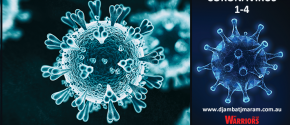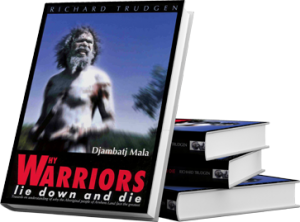16. Traditional Yolŋu “social distancing” law
In this program the phrases “physical distancing” and “social distancing” are discussed from a Yolŋu worldview. These are two English concepts used in conversations about coronavirus that Yolŋu people find difficult to understand. But there are actually two similar processes in Yolŋu culture to compare it to. One is ‘avoidance relationships’ of some people, as part of the kinship structure. The other is an intricate concept called goŋ-wukundi.
Goŋ-wukundi comes into practice under Yolŋu Madayin law, when somebody touches a dead body or is associated with caring for a person who has passed away, while they are in the coffin, through the ceremonial process before burial. The group looking after the deceased become goŋ-wukundi; their hands are painted with yellow, white or red ochre to distinguish them from others. People outside this group are not allowed to be near them, touch them, or touch any of the articles they’ve used, like their plates or food. These concepts are used to explain social distancing in regard to stopping the spread of coronavirus.
17. No microscopes to describe viruses in the past
In this program, social distancing is discussed as a way to stop the spread of coronavirus. The Yolŋu goŋ-wukundi law is for the same reason – to stop the spread of disease. There is discussion around the the goŋ-wukundi law given to Yolŋu by the Great Creator Spirit, Waŋarr. This was necessary before the development of microscopes and before people knew the reasons why social avoidance was required to control the spread of disease and sickness.
The word warrakan (animal, birds, meat) is used in this program when referring to live disease agents like bacteria and viruses. The term buwayak warrakan (invisible animals, birds, meat) is also used to name bacteria so Yolŋu people can better understand bacteria and viruses as living disease agents that can multiply and cause problems in the body.
18. Looking for medicine to stop the virus
In this program, the Yolŋu concept of ‘ḏilthan’ is explained as a process where people take particular trees and plants, crush them and throw them into water. This takes place particularly in deep water where they can’t get there to fish with a spear. The chemicals from the trees and plants kill the fish and they rise to the top of the water, but they are still edible. Dilthan is also the name for when people get sap on their skin from the ganyawu tree (also known as the rrayung or bunydjarrnga tree) and if don’t wash it off quickly their skin swells up (bolbolyun) and small infected, watery heads appear.
Medical companies are trying to find the right chemical to ‘ḏilthan’ or ‘stun’ the coronavirus. This program explores the two ways that are being considered: one will destroy the virus and the second will involve finding a chemical that blocks or renders useless the spines in the little arms of the virus that can inject its chemical into body cells to make more viruses.
Click here for the full Covid:19 playlist
Other education programs in Yolŋu Matha are available on the Why Warriors YouTube channel or via the Yolŋu Matha learning platform, www.djambatjmarram.com.
These COVID-19 resources are produced by Rev Dr Djiniyini Gondarra, Richard Trudgen and Dr Kerry Mills. Thank-you to © Helix Animation 2020 for the animations provided. All rights reserved.



